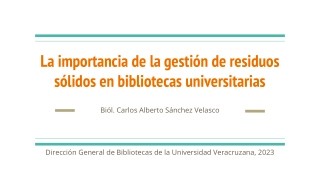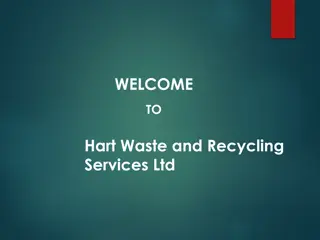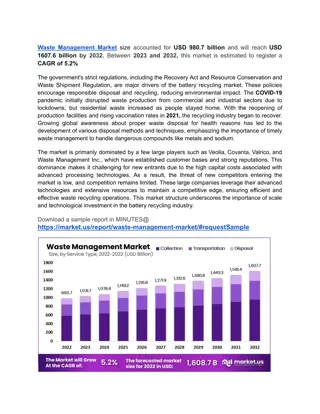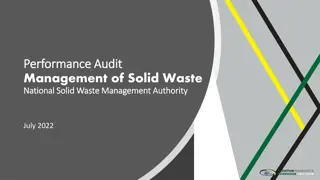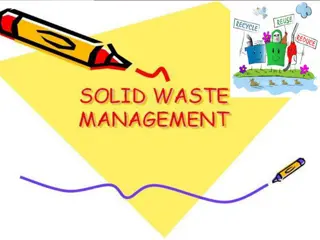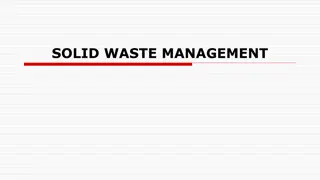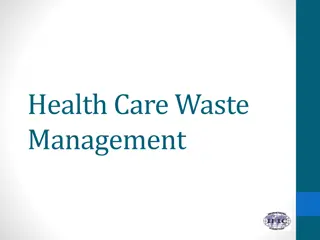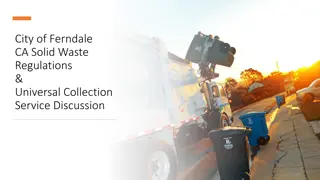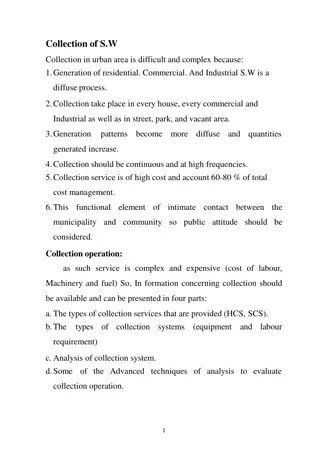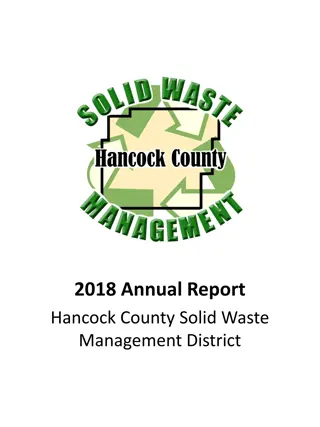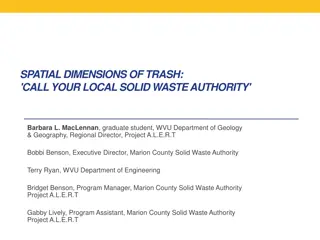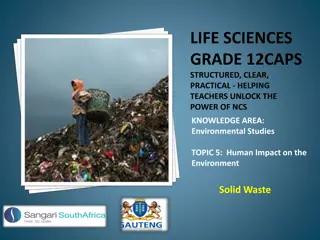Effective Solid Waste Management Strategies for Communities
Solid waste management is crucial for maintaining hygiene and preventing health hazards in communities. Proper storage and collection methods ensure efficient waste disposal and reduce environmental impact. This paper presentation discusses the importance of waste management, emphasizing the need for cooperation among residents, standardized containers, and segregation of waste. It highlights the challenges of inadequate waste collection and provides solutions to enhance the efficiency of waste management systems.
Download Presentation

Please find below an Image/Link to download the presentation.
The content on the website is provided AS IS for your information and personal use only. It may not be sold, licensed, or shared on other websites without obtaining consent from the author. Download presentation by click this link. If you encounter any issues during the download, it is possible that the publisher has removed the file from their server.
E N D
Presentation Transcript
G.H. RAISONI COLLEGE OF ENGINEERING PAPERPRESENTATION ON: STORAGE & COLLECTION OF SOLID WASTE MANAGEMENT (SUBJECT: MUNICIPAL SOLID WASTE MANAGEMENT)
INTRODUCTION Waste is continuously produced as a result of human activities. Waste must be stored and transported at specific frequencies. Removal of waste from individual houses is termed as collection of waste and carried out by various methods. The collection system require co- operation of the residents.
INTRODUCTION In case of inadequate co-operation and inefficiency in collection of waste aesthetic problems arises due to accumulation of material leading to smell and odour problems, proliferation of flies, mosquitoes and other vectors leading to transfer of infection resulting in increased morbidity. The expenditure on collection amount to 45-75% of total cost of solid waste management system in India. The collection of cost reduces in terms of percentage of total cost.
STORAGE AT PREMISES Waste must be kept in standardized containers for house to house collection system. The capacity of container must be designed after taking into consideration, the contributing population and the frequency of removal of waste. Waste must be kept in standardized containers for hose to house collection system. The capacity of container must be designed after taking into consideration, the contributing population and the frequency of removal of waste.
STORAGE AT PREMISES Depending upon the reliability and frequency of waste removal, additional capacity must be designed. The storage containers should be so designed as to be compatible with the vehicle used for transportation. Use of non standard containers increases the time required by the collection crew in collecting and emptying their in vehicles. The storage containers should be of plastic with a detachable cover.
STORAGE AT PREMISES: In the community bin system of collection the storage containers located in the premises need not be of standardized design and the residents can be encouraged to use any suitable containers. However, precautions should be taken to ensure that the stored waste is not exposed and does not come in contact with moisture and vectors of disease. In individual households, the waste should preferably be segregated into dry and wet waste. The recyclable as welt as the hazardous constituents should be stored separately.
STORAGE AT PREMISES The recyclable can be collected / sold to rag pickers while precautions should be taken while disposing of hazardous waste. The wet waste should be stored in non- corrosive containers with lid and should be removed from the household every day. The wet waste should be stored in non- corrosive containers with lid and should be removed from the household every day. In commercial areas major problem arises when there is non synchronization of the working hours of the establishments and the cleansing workers.
STORAGE AT PREMISES The commercial establishments should hence store their waste till the collection workers arrive to collect it. Establishments generating biodegradable waste such as hotels and restaurants should make their own arrangements to store the waste in non-corrosive containers and its frequent removal. Similar precautions need to be taken in the markets where biodegradable waste is generated as in the case of fruit and vegetable or fish market.
FREQUENCY OF COLLECTION Accumulated waste in the premises must be removed at specific frequency depending on size of container and composition of waste. Municipal agencies are responsible for collection of waste. Waste consists of organics, recyclables such as paper, plastic, glass etc. and non-decomposable.
FREQUENCY OF COLLECTION If the material with high organic and moisture content from residential areas is not collected for a long time it tends to degrade quickly at the higher ambient temperatures encountered in India. Further, the fly eggs deposited in such material hatch within 1 day and the larvae will feed on the waste for 5 days before pupation which takes 3 more days. It is therefore desirable that the waste is removed as quickly as possible and at least once in 5-6 days to ensure that the flies do not emerge out of the deposited eggs. It is essential to remove the waste atleast twice or thrice a week.
FREQUENCY OF COLLECTION In the house to house collection if the dwellings have an adequate space for storage of the containers, daily collection may not be necessary. However, if the dwellings are too small or in clusters without suitable storage space, daily collection should be encouraged. Table gives the frequency of collection recommended in different types of areas in different classes of cities.
SERVICE STANDARDS FOR SOLID WASTE COLLECTION: FREQUENCY TYPE OF LOCALITY Class I Cities Class II Cities Population > 1lakh Population-50,000 to 99,999 Residential Areas Area with high population density. Area with medium population density. High income area. Area with low population density. Once or twice a day Once day Once or twice a day Once in two days Once or twice a day Once a day Once in two days Once in three days Markets Commercial Areas Industrial Areas Once or twice a day Once or twice a day Twice a day Once a day Once a day Once a day
HOUSE TO HOUSE COLLECTION: Refuse generated and stored in individual premises is collected by several methods such as: Curb service i. ii. Alley service iii. Set-out, set-back service iv. Set-out service v. Backyard service
CURB SERVICE: Refuse container is placed at the curb on scheduled day by house owner. Workmen collect and empty in the collection vehicle and place them back at the curb. House owner take the container back to their house.
VEHICLE ROAD HOUSE NO. 1 2 3 4 WASTE STORAGE ALLEY 7 5 6 8 ALLEY ALLEY ROAD CURB SERVICE
ALLEY SERVICE: Containers are placed in the alley line. Workmen are allowed to pick and deposit back the empty container.
VEHICLE ROAD HOUSE NO. 1 2 3 4 WASTE STORAGE ALLEY 7 5 6 8 ALLEY ALLEY ROAD ALLEY SERVICE
SET-OUT, SET-BACK SERVICE: Set-out men go to individual houses. Collect and empty the container in solid waste collection vehicle. Another group of persons return them to house owner s yard. SET-OUT SERVICE: Workmen collects the solid waste container, empty them in the collection vehicle. House owner take back the empty container.
VEHICLE SET-OUT MEN HOUSE NO. 1 2 3 4 ALLEY 7 5 6 8 ALLEY SET-IN MEN ROAD SET-OUT, SET-BACK SERVICE
BACKYARD SERVICE: Worker carry a bin, handcart or sack or cloth to the yard and empty the solid waste container in it. Handcart or bin is emptied in the solid waste collection vehicle.
COMPARISON OF VARIOUS METHODS OF HOUSE TO HOUSE COLLECTION: SR. NO. CURB SERVICE ALLEY SERVICE SETOUT, SET-BACK SERVICE SETOUT SERVICE BACKYARD SERVICE DESCRIPTION 1. House owners cooperation is required: i. To carry full cans ii. To carry empty cans YES YES OPTIONAL OPTIONAL NO NO NO NO NO NO 2. YES NO NO YES NO Scheduled service is necessary for obtaining house owners cooperation 3. YES YES NO YES NO Prone to upset 4. 1-3 1-3 3-7 1-5 3-5 Average crew size 5. LOW LOW HIGH HIGH HIGH Complaints regarding trespassing 6. - Requires Special vehicle - - - Special service 7. Evaluation with reference to: i. Service to citizens ii. Crew cost POOR HIGH LOW FAIR FAIR MEDIUM LOW GOOD GOOD MEDIUM
COMMUNITY BIN SYSTEM: Bins are located at street corners. Waste is brought and deposited in the bins. Capacity of community bins -at least 50%, for daily collection & -100%, for alternative days. Distance of containers should not be more than 100m.
BELL RINGING SYSTEM: Collection vehicle is provide with a bell and rung at specified points. Residents from adjoining areas come to the vehicle and deposit the waste. Sometimes the bell is used as a informing system for the residents.
STREET CLAENSING: Street waste comprises of- i)Natural waste. ii)Traffic waste. iii)Behavioural waste. Manual sweeping is carried out with short/long handled brooms. Work is carried out in pairs- one person (commonly female) sweeping the road and other collecting the swept material in a handcart. Two shifts- 6am to 12pm and 2nd from 3pm to 5pm.
TRANSFER OF COLLECTED WASTE The waste collected after sweeping must be transferred to the community bin and thereafter to the waste transport vehicle. Transfer of waste to community bins is commonly made by using cane or plastic baskets. If these are to be directly taken to the community bin, it is time consuming and leads to reduced productivity of the workers. Handcarts of suitable design and capacity improve the productivity and should be so designed as to enable transport of large quantities of the low density municipal solid waste.
TRANSFER OF COLLECTED WASTE Handcarts usually deposit their contents by the side of the bin from where it is lifted and deposited into the bin. If the handcart contains a number of containers these can be directly emptied into the bin thereby reducing the number of handling steps. The waste from the bin is often manually lifted and transferred by head loads to the vehicle. If the bin can be directly taken away on the vehicle chassis, the handling steps will be reduced.
TRANSFER OF COLLECTED WASTE When the rim of the sideflap of the vehicles is higher than 1.6 m, a sweeper must be stationed inside the vehicle to collect the basket from the worker standing on the road and deposit it inside the vehicle. This exposes the workers to increased risk of transfer of infection. The present system of collection is labour intensive and neither standardized work norms nor appropriate equipment and methods are used, the productivity of the workers is less than the desirable value of k day/worker. The values recorded in some Indian cities are given table:
CITIZENs PARTICIPATION For efficient collection of the solid waste active participation citizens is essential. Presently this is lacking and needs to be improved. It is desirable to create awareness in the citizens mind of the need to actively participate in then efforts to maintain a clean environment. Citizen should be made aware of the ill effects of unclean environment on their physical health as well as economic health by citing the example, of Surat when due to the plague epidemic of 1994, in addition to the health effects, the diamond industry as well as the tourism and the image of the city suffered resulting in tremendous loss.
CITIZENs PARTICIPATION The need for the active participation of the citizens and the benefits that accrue to them in terms of aesthetic, environmental and health benefits should be stressed. It should be impressed on them that in addition to the municipal authorities it is equally their responsibility to maintain a clean environment. They should be made aware of the vital role of source separation in improving collection and disposal. The importance of 3 R s- Reducing, Recycling and Reusing the waste should be impressed on them by conducting various campaigns. RECYCLE SYMBOL
CITIZENs PARTICIPATION Creating awareness is the first step towards changing of habits. Once the habits are changed, a sustained campaign involving government agencies, NGOs, CBOs will help maintain a clean environment. Advertisements and messages in the form of catchy slogan will help create awareness among adults. Short films, skits and cartoon film on TV. can be arranged. Messages can be included on hoardings, stickers, posters, on products such as milk pouches etc.
CITIZENs PARTICIPATION The municipal agency should encourage private organizations to sponsor events and campaigns for improving awareness by providing them tax benefit. Children are the future citizens and changing their behaviour when they are still young and impressionable will ensure a better environment in future. Children influence their elders and thus help change their behaviour also. In addition to including the subject in the school curriculum, essay, painting, quiz competitions and debates should be arranged to ensure their sustained active involvement.
CITIZENs PARTICIPATION The best strategy is to mount a high profile campaign for two months followed by a low profile campaign for next four months. For best effects the T.V., Radio and News paper campaigns should be taken up first followed by posters and outdoor publicity. It is also desirable to carry out clean area contests among various wards of the city and the wards giving the best results be rewarded. Such a reward system should preferably provide sustained additional civic benefits such as provision of a larger frequency of solid waste collection, provision of larger hours of water supply etc. To ensure active participation of the citizens, citizens forums should be formed comprising of citizens representatives, prominent citizens, social workers and municipal officials.
CITIZENs PARTICIPATION These forums should be created in every individual ward and decisions regarding the location of community bins, the frequency of cleansing and such related matters should be taken in consultation with the forums. Besides taking their help in decision making, a continuous dialogue should be maintained at these meetings so that the complaints of the residents reach appropriate municipal authorities and are expeditiously resolved. A review of the action taken on past complaints will ensure that satisfactory solutions are found. Whenever the clean area contests are held the benefits should be extended to the winning ward as also to the municipal workers in that ward so that they continue to feel involved and take pride in their work.
ROLE OF NGOs and CBOs It is desirable to involve NGOs and CBOs who will work as catalytic elements and improve the collection efficiency resulting in improved environment. The NGOs in Bangalore, Chennai and Mumbai etc. are known to play a very important role by working with the citizens and the unorganized waste pickers to ensure a clean environment. Some Resident Welfare Associations have also taken initiative and arranged collection of waste from premises through hired workers or waste pickers and arranging the recycling and proper disposal of the waste. Various NGOs in their efforts to prove the literacy level, working environment and financial condition of the waste pickers have organized them, provided them an identity, and with the co-operation of the residents arrange collection of waste from individual premises by the waste pickers.
ROLE OF NGOs and CBOs The NGOs convince the residents of the need to separate recyclables from non recyclables and in some cases even provide the residents with bags (provided free by companies who print their advertisement on the bag) for this purpose. The waste pickers collect the waste from individual premises and as the waste is presorted sell the recyclables at better price and thus are able to provide their services at a nominal fee. The NGOs receive the fee from residents, arrange vermi composting of organics and sell the product. The money so obtained is used for providing the implements, uniform and pay to the workers/waste pickers.
ROLE OF NG0s and CBOs The system results in maintaining a clean environment, avoids the nuisance of waste pickers spreading the waste during their search for recyclables in the waste bins and also help the waste pickers to play a useful role in the society. The recyclables are directly taken away and sold by the waste pickers and the organics are converted to vermi-compost by the NODs, Only a small quantity remains to be collected from the bins reducing the expenditure on its transport by the municipal agency. Thus in addition to improved environmental conditions, the municipal agency also saves on transport cost. The municipal agencies should hence seek the co-operation of NGOs in improving the collection from premises, recycling of the constituents and improvement in environmental condition.
MOTION-TIME-MEASUREMENT TECHNIQUES(MTM) MTM is used to determine the best sequence of activities that workers must follow in order to complete a repetitive task in the shortest possible time, the best combination of equipment to maintain a desired level of output, reduce health problems relative to the repetitive work sequence and predict the effects of change in materials handled. Such a study carried out on macro scale for the collection will analyze the time spent by the crew for collection, resting, idle time, unauthorized activities, hauling and travel time. The study is carried out by following the collection crew and identify time needed for every activity.
MOTION-TIME-MEASUREMENT TECHNIQUES(MTM) Analysis of data will reveal the area where changes can be carried out to improve performance. When collection crew travels along with the vehicle for transfer of waste from community bins to vehicle, they should get down after the vehicle is full and before it proceeds to the processing/disposal site. They should be dropped at such a place where they can join another vehicle and help in its loading. Operation of such a relay system helps optimize the workers time and hence productivity.
COLLECTION SYSTEM IN DIFFERENT CLASSES OF CITIES The collection of waste should be carried out by following the above procedures. However, modifications to the system should be made to suit different occupation groups. In the case of commercial areas where the waste predominantly consists of paper and plastics and such other recyclable materials, the collection system should use larger sized handcarts for the voluminous nature of the waste.
COLLECTION SYSTEM IN DIFFERENT CLASSES OF CITIES It is desirable to collect the waste at a much higher frequency due to the larger number of people visiting such areas and as the commercial establishments usually do not have additional space for storage of the material. It is also desirable to opt for privatization of the collection system, as it will be easier to recover the charges from various establishments. In the case of majority of urban centers a large proportion of the population resides in old parts of the towns which are conjested and have only narrow lanes. However, in the case of small scale industries which are located within the urban limits the waste is often deposited in the community bins.
COLLECTION SYSTEM IN DIFFERENT CLASSES OF CITIES It is hence desirable to provide a collection system similar to that of commercial areas. In the case of different classes of cities (as defined by Census of India) the collection system will not differ much except in the use of the implements and the frequency of collection. In the case of smaller towns, the implements must be selected after taking into consideration the type of waste, type of maintenance and the available repair facilities. The type of implements to be used after the consideration of these parameters, are described in detail in Chapter 8.



